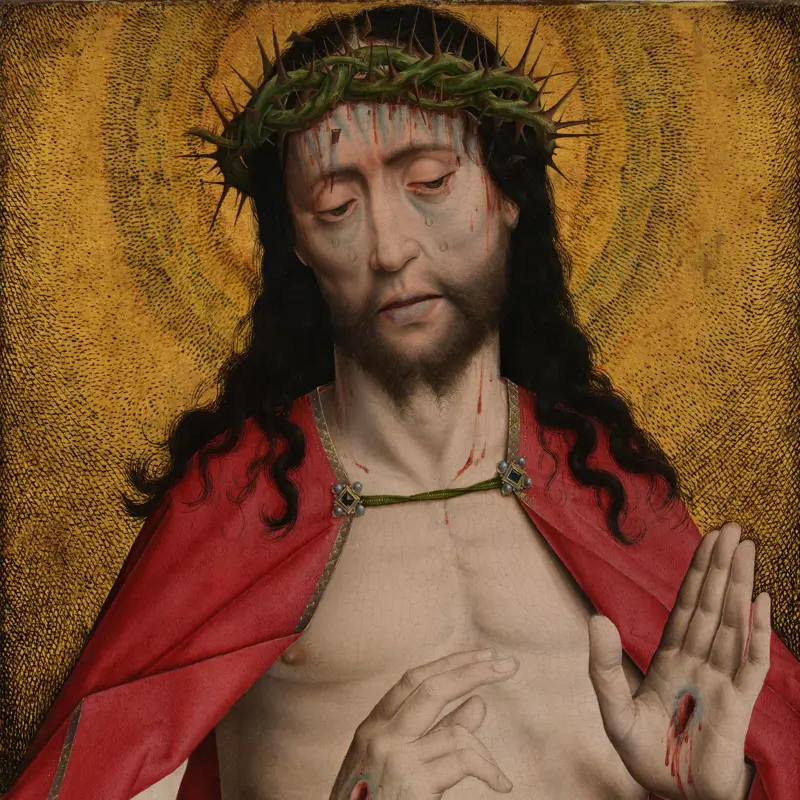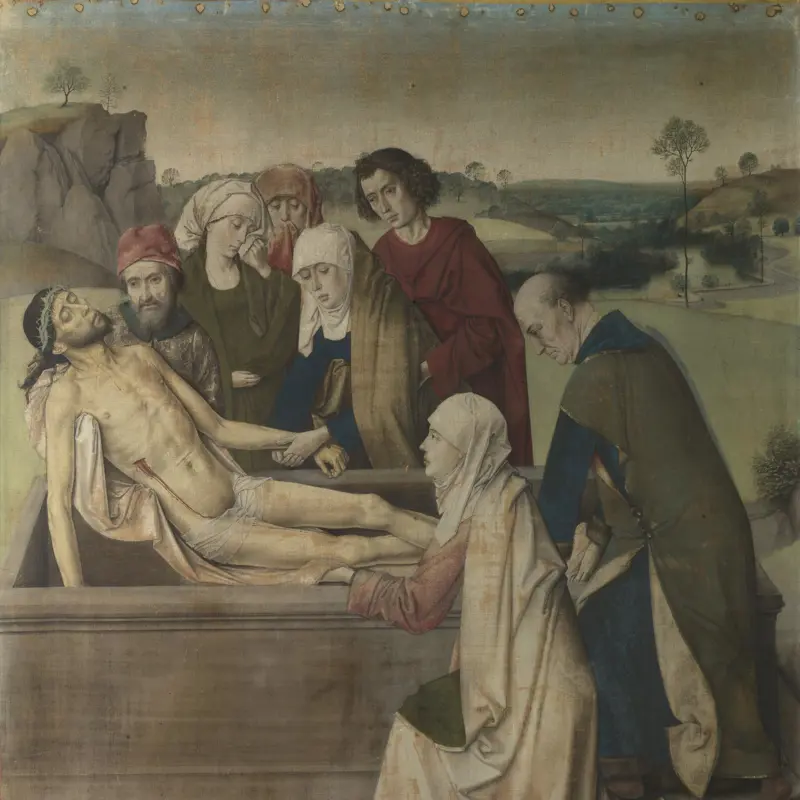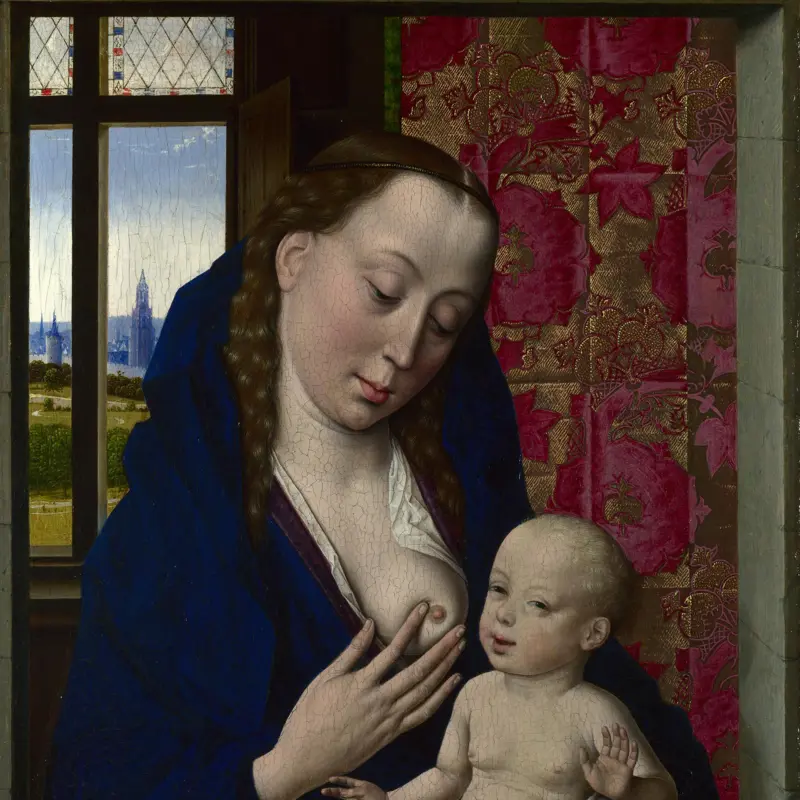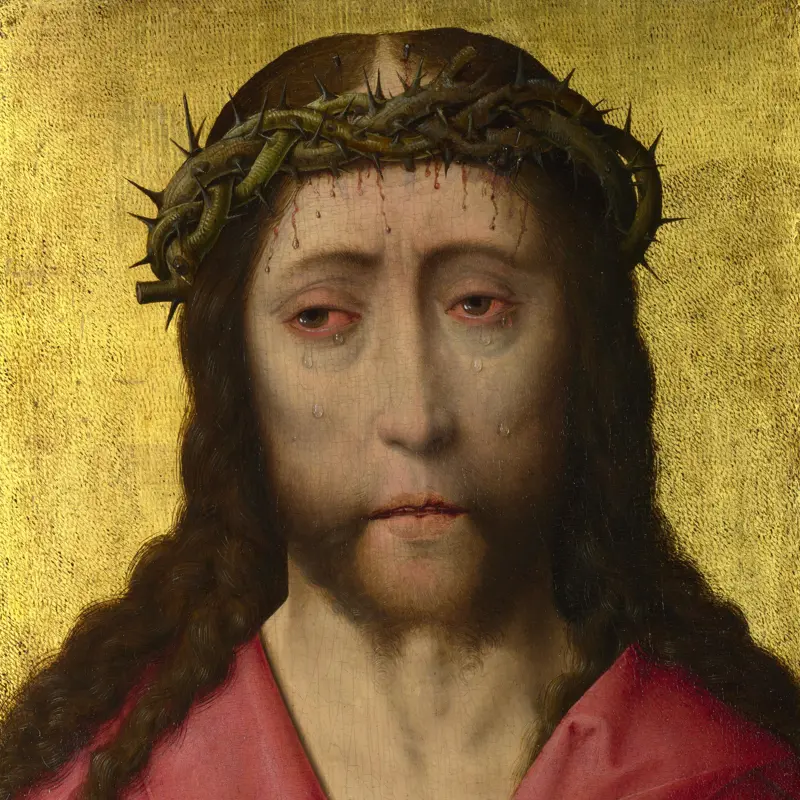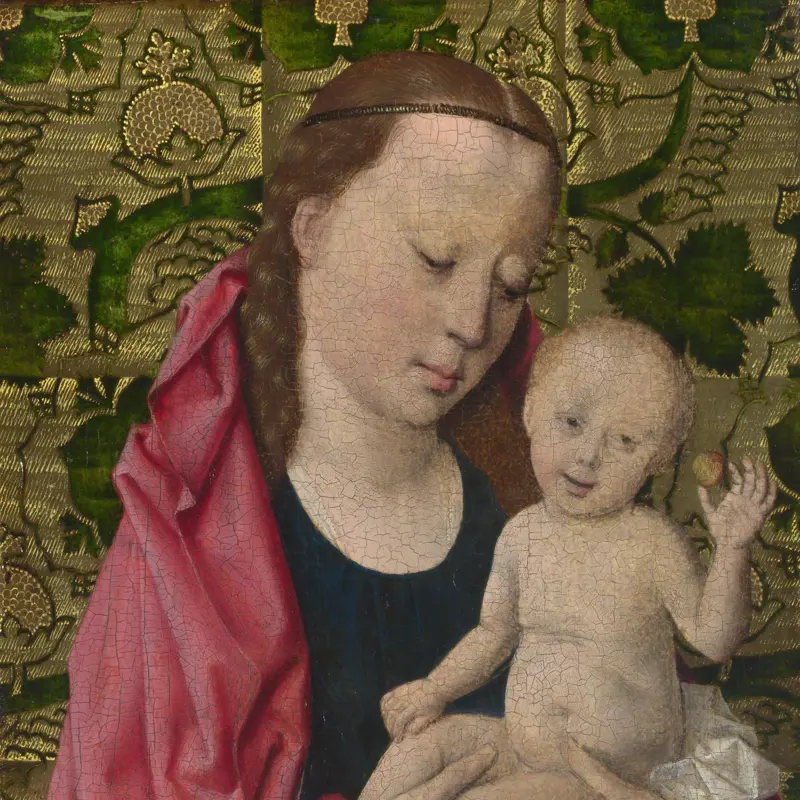Workshop of Dirk Bouts, 'The Virgin and Child with Saint Peter and Saint Paul', probably 1460s
About the work
Overview
The Virgin, holding the infant Christ, sits on a marble throne with a luxurious material stretched across it – a cloth of honour, something often hung behind medieval royalty. Two saints stand with them, and particular symbols tell us who they are. On the Virgin’s right is Saint Peter, a key peeping out from beneath his green robe. On the Virgin’s left is Saint Paul, the sword by which he was martyred leaning against the arch behind him. He holds out a delicate flower to Christ: a carnation. Carnations or pinks were known in northern Europe as ‘nail flowers’ because their scent resembles cloves, which are shaped like the nails driven into Christ’s body when he was crucified. So this little flower may allude to the Passion (Christ’s torture and crucifixion).
Key facts
Details
- Full title
- The Virgin and Child with Saint Peter and Saint Paul
- Artist
- Workshop of Dirk Bouts
- Artist dates
- 1400? - 1475
- Date made
- Probably 1460s
- Medium and support
- Oil on wood (Baltic/Polish oak, identified)
- Dimensions
- 68.8 × 51.6 cm
- Acquisition credit
- Bought, 1867
- Inventory number
- NG774
- Location
- Not on display
- Collection
- Main Collection
- Previous owners
Provenance
Additional information
Text extracted from the ‘Provenance’ section of the catalogue entry in Lorne Campbell, ‘National Gallery Catalogues: The Fifteenth Century Netherlandish Schools’, London 1998; for further information, see the full catalogue entry.
Exhibition history
-
2023Dieric Bouts. Creator of imagesM - Museum Leuven20 October 2023 - 14 January 2024
Bibliography
-
1857London, National Gallery Archive, NG22/15: Charles Eastlake, Eastlake Notebook, 1857, vol. 2, p. 13
-
1864London, British Library, BL Add. MS. 38990: Letter from Sir Charles Eastlake to Sir Henry Layard: 30 December 1864, 30 December 1864
-
1867R.N. Wornum, Descriptive and Historical Catalogue of the Pictures in the National Gallery, London 1867
-
1882W.M. Conway, 'A Picture by Rogier van der Weyden and One by Dieric Bouts', The Academy, XXI, 1882, pp. 212-3
-
1887W.M. Conway, Early Flemish Artists and Their Predecessors on the Lower Rhine, London 1887
-
1888E.T. Cook, A Popular Handbook to the National Gallery Including, by Special Permission, Notes Collected from the Works of Mr. Ruskin, London 1888
-
1889National Gallery, Descriptive and Historical Catalogue of the Pictures in the National Gallery with Biographical Notices of the Painters: Foreign Schools, London 1889
-
1904M.H. Witt, The German and Flemish Masters in the National Gallery, London 1904
-
1908E. Brunelli, 'Opere d'arte nel palazzo Marullo di Castellaci a Ragusa inferiore', L'arte, XI, 1908, pp. 223-4
-
1911National Gallery, An Abridged Catalogue of the Pictures in the National Gallery, London 1911
-
1924M.J. Friedländer, Die altniederländische Malerei, 14 vols, Berlin 1924
-
1925C.J. Holmes, Old Masters and Modern Art: The National Gallery, the Netherlands, Germany and Spain, London 1925
-
1927E. Michel, Early Flemish Paintings in the Renders Collection at Bruges, London 1927
-
1927O. Pächt, 'Review: M. J. Friedländer, Die altniederländische Malerei, Vol. 3, 1925', Kritische Berichte zur Kunstgeschichtlichen Literatur, I, 1927, pp. 46-7
-
1932L. Baldass, 'Die Entwicklung des Dirk Bouts', Jahrbuch der Kunsthistorischen Sammlungen in Wien, VI, 1932, pp. 77-114
-
1934R.N.D. Wilson, The National and Tate Galleries, London 1934
-
1940L. Baldass, 'Dirk Bouts, seine Werkstatt und Schule', Pantheon, XV, 1940, pp. 93-7
-
1945Davies, Martin, National Gallery Catalogues: Early Netherlandish School, London 1945
-
1953M. Davies, The National Gallery, London, Les Primitifs flamands. I, Corpus de la peinture des anciens Pay-Bas méridionaux au quinzième siècle 3, 2 vols, Antwerp 1953
-
1955Davies, Martin, National Gallery Catalogues: Early Netherlandish School, 2nd edn (revised), London 1955
-
1962H. Adhémar, Les primitifs flamands. I. Corpus…, 5, Le Musée National du Louvre, Paris, Brussels 1962
-
1967M.J. Friedländer, Early Netherlandish Painting, eds N. Veronée-Verhaegen and H. Pauwels, trans. H. Norden, 14 vols, Leiden 1967
-
1973A. Emiliani (ed.), La Collezione Zambeccari nella Pinacoteca nazionale di Bologna, Bologna 1973
-
1975J.M. Collier, Linear Perspective in Flemish Painting and the Art of Petrus Christus and Dieric Bouts, Phd Thesis, Michigan University 1975
-
1978D. Robertson, Sir Charles Eastlake and the Victorian Art World, Princeton 1978
-
1987Davies, Martin, National Gallery Catalogues: The Early Netherlandish School, 3rd edn, London 1987
-
1991J. Dunkerton et al., Giotto to Dürer: Early Renaissance Painting in the National Gallery, New Haven 1991
-
1993D. Martens, 'La "Madone au trône arqué" et la peinture brugeoise de la fin du Moyen Âge', Jahrbuch der Berliner Museen, XXXV, 1993, pp. 129-74
-
1994D. Martens, 'Un eco castellano de la Madonna del trono arqueado de Dieric Bouts', Archivo español de arte, LXVII, 1994, pp. 149-59
-
1994G.-N. Anderson and J. Wright, Heaven on Earth: The Religion of Beauty in Late Victorian Art, (exh. cat. Djanogly Art Gallery, University of Nottingham, 7 October - 27 November 1994), Nottingham 1994
-
1996J. Kirby and R. White, 'The Identification of Red Lake Pigment Dyestuffs and a Discussion of their Use', National Gallery Technical Bulletin, XVII, 1996, pp. 56-80
-
1998Campbell, Lorne, National Gallery Catalogues: The Fifteenth Century Netherlandish Paintings, London 1998
-
1998C. Fisher, Flowers and Fruit, London 1998
-
1998M. Smeyers, Dirk Bouts: Schilder van de Stilte, Louvain 1998
-
2001
C. Baker and T. Henry, The National Gallery: Complete Illustrated Catalogue, London 2001
About this record
If you know more about this work or have spotted an error, please contact us. Please note that exhibition histories are listed from 2009 onwards. Bibliographies may not be complete; more comprehensive information is available in the National Gallery Library.

